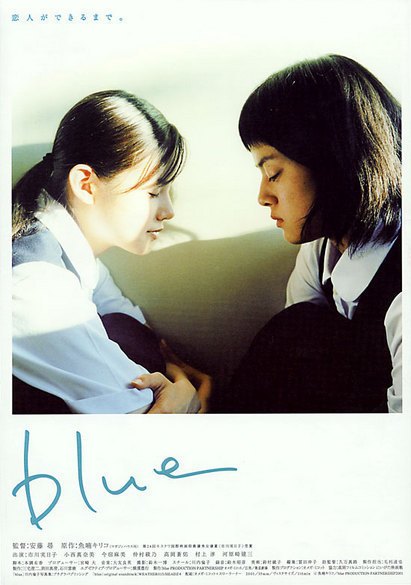The film evolves around two high school girls who struggle with their own life-world crisis during the adolescence. Loneliness, love, passion and encountering otherness are some of the appealing themes of the movie.
by Mahesh Hapugoda
Film: Blue (2001)
Director: Hiroshi Ando
Language: Japanese
Genre: LGBT, Romance
(December 10, 2017, Colombo, Sri Lanka Guardian) Historically, we live in profound uncertainties. Fragile politics and structural inabilities overshadow our existence. Corruption is the only dynamic that matters to individualism today. Since everyone wants to be rich, selfishness is a universal ethic that no one contests. Ideals of the previous century are no longer valid or applicable. Sexual orientations are diverse and the differences are over-emphasized undermining the mega social projects that defined the humanity in the previous era. In this egocentric cold water, everything is dissolved as liquid content giving birth to a new form of existentialism. In that context, profit is the only currency that buys everything and everything is determined by it. If ‘the essence’ of existentialism in the 20th century is ‘nothingness’, the 21st century existentialism is made of ‘obscenity’ because, unlike in the previous century, it opens up a huge market place. One’s petit desires can be converted to a big market space and can be profitably sold to another group of pervert consumers. This is where social media comes in as a virtual prop to propagate, distribute and profit from the previously hidden obscene content of individuals. If one can negate the propagation of such highly individualistic fantasies and concentrate on depicting the complex existential crisis of individuals, such art phenomenon is doomed to fail in the global market. But a true radical act would also be based on the denial of the same thing that the market is made of.
The film ‘Blue’ (2001) directed by Hiroshi Ando has apparently received negative comments from many critics around the world. It can be understood that the reason for such negative reception may rest on its lack of popular elements, use of extensive conversation and the slow character development employed by the director. No need to mention that the director does not follow the hegemonic stereotypes cheaply available in Hollywood. Instead, he adapts his own poetic way of expressing the cinematic idea about a very appealing and a passionate relationship between two Japanese high school girls. Even the Japanese commentators do not seem to understand the deep existential meaning behind this movie, inspired by popular Japanese writers such as Yasunari Kawabata or Kazuo Ishiguro. Based on the thematic significance, it can be considered as a progressive and an aesthetic movie when it is contextualized in relation to the depicted lesbian romance within the contours of the global LGBT movement. Hiroshi Ando bravely talks about the complex existential struggle a lesbian lover faces in the contemporary Japanese society without deeply disturbing the existing values that glue the societal harmony. Then he leaves it to social critics to decide whether the existing norms and values should also alter under new global cultural conditions.
Watch The Movie ( Blue)
Self-awareness or the consciousness can be the greatest gift that human subject can receive from the other. Not the physical encounter. The reason why the European readers are shocked by Japanese masterpieces is that characters like Izu Dancer maintain a mysterious- incomprehensible distance from the other.
The film evolves around two high school girls who struggle with their own life-world crisis during the adolescence. Loneliness, love, passion and encountering otherness are some of the appealing themes of the movie. They don’t worry about the outside world or its never ending political rhetoric, Tsunami warnings, environmental crisis or regional conflicts. By using each other as mirrors they travel an internal journey towards their own existence in order to discover its conditions, limitations and possibilities. Endo has already crossed so many boarders to find out her love, or rather to find out who deserves her love. When Kirishma loves her, she open-heartedly accepts it without hurting her. When that married man wants her love she forgets everything else and goes to comfort him, give him much needed love and to heal his wounds. She has gone to an extent that she got an abortion during her school days. She goes with the flow and, may be no one can permanently possess her including Kirishima. She is also not fully detached from them either. She is there but she is not there. She is like an angel who passes by everyone like a cloud which appears in the end of the film. Comparatively, this has been a common metaphor used by Kawabata. In his ‘Little Izu Dancer’ (even Morning Clouds), the young man from Tokyo never fully encounters the little dancer. He could not get the return for his love for her. But he comes to know through her words that ‘he is a nice man’ in contrast to his own misanthropic feeling in Tokyo. He has to come to the country to heal his wounds caused by the city. He never meets the Izu dancer but meets himself through her. That is the gift that she returns for his love. Self-awareness or the consciousness can be the greatest gift that human subject can receive from the other. Not the physical encounter. The reason why the European readers are shocked by Japanese masterpieces is that characters like Izu Dancer maintain a mysterious- incomprehensible distance from the other. That distance, at some crucial moment, becomes a true gift. The young Tokyo boy could not immediately understand this distance but with self-awareness he is able to. Silence consumes time but awareness also comes with time. Hence, the silence becomes an eye-opener. The un-meeting becomes the true meeting of their lives.
Some critics point out that this is a ‘painstaking slow’ movie and sometimes slower that the slowest movie in Japanese. In a psychoanalytical sense, what does this slowness explain to us? If there is an uncommon slowness in making choices, it comes with an existential condition that leaves characters responsible for their decision. Endo leaves Kirishima and goes to Tokyo leaving her alone for the entire summer. On one hand, she creates a ‘de-territorialized space’ for Kirishima by changing her geo-spatial location and giving Kirishima an enough time to think and rethink about their relationship and its meaning. On the other hand, by leaving her alone, she generates an absence, a metaphorical psychoanalytical vacancy for the replacement of her erotic drive for a higher course. In this way, when the libidinal drive is changed into a more creative spirit, the slowness has a profound meaning. Such process consumes a lot of time but, in the end, humanity can reach certain creative height that it has never imagined before. As far as French-Japanese cult film In the Realm of Senses (1976), The Last Tango in Paris (1972), Basic Instinct (1992) or most of the erotic experiments by Lars Von Trier are concerned, at least in their European sense, the erotic libido insatiably ends up in a death drive never reaching a higher human goal. It is because other than the sexual drive as the first choice they do not know anything about the second choice that can make a true difference. Kirishima’s first choice was an erotic one. Here what Endo does is very similar to a role of an analyst. First, she agrees with her first choice but then she gives her the space to make a second choice, if there is any. It is in this ‘de-territorialized vacancy’ that Endo created in Kirishima’s life gives her the opportunity to reach enlightenment – the withdrawal as well as the cogito space – the maturity. Therefore, truth is always slow.
The unconscious is often transgressive and does not care for the symbolic law. The unconscious decision is always subjective but conscious one is the ground for subjective freedom.
According to psychoanalysis, there are two types of decisions; conscious and unconscious. Kirishima’s first decision was an unconscious one. She was a lonely, silent and an introvert girl who wanted a companion. She chose Endo because Endo was of a special kind. But her second decision to love painting was a fully conscious one which comes in as a replacement of first unconscious one. The unconscious is often transgressive and does not care for the symbolic law. Kirishima’s love for Endo was meant to go beyond the symbolic structure, and this was very similar to Endo’s relationship with the married man and her unfortunate abortion. But the conscious choice that she makes afterwards remains fully within the symbolic order. What happens when she becomes conscious is her fantasy disappears. So, an analyst must always go to the level of the unconscious (the Real) to convince the patient that his or her unconscious truth is symptomatic. An analyst must deal with the unconscious abstraction to traverse the patient’s fantasy – his or her passionate attachment to the fantasized scene of objectification. When Kirishima objectifies Endo’s physical love, Endo becomes Kirishima’s master signifier (for example, remember how Kirishima begs for Endo’s love in the beach). When the patient takes a decision based on the master’s discourse, such decision never becomes a free choice because the subject is already caught in the discourse of the master. But once the fantasy element is eliminated when she chooses to improve her painting skills, then she becomes liberated from the master and her choice is an objective one. The unconscious decision is always subjective but conscious one is the ground for subjective freedom.
When Kirishima understands that Endo loves this strange married man more than her, she takes a decision to keep a distance from her. That distance gives her the cognitive space to rethink what has been happening between them. She becomes introvert and starts reviewing the whole episode, contemplating and defining her own existence. She overhears some important information about Endo. She realized that Endo’s first place is always vacant even if that married man leaves her. That vacant first place slot will be filled by another but Kirishima will always be the ‘second’, filling the second slot. With her complete love for Endo, Kirishima always wants to be the first but that never seems realistic since Endo has already given her first place to someone. It will always be the first place that will be replaced by another first one by not be Kirishima. Their separation was metaphorically similar to what Kawabata portrays in his stories, weeping, crying and then healing the wounds. Kirishima and Endo cry and then reach the stage of self-realization. A marriage is not possible and they have to choose their own paths in life. Kirishima will continue to study painting and Endo will be an uncertain subject for the rest of her life, at least till she discovers who she is and what she wants to become of. Then they separate but with a true meeting of their inner souls. That will be the most important lesson for a high school girl who goes in search of the meaning of life through sexuality. Sex will always be mischievous but, if you are intelligent enough, even a higher meaning can be derived through its mischief.
However, the meeting between Kirishima and Endo was quite different from the ordinary Hollywood stereotype where one meets the other and passionately goes for a physical relationship. The filmmaker never makes an emphasis on the physical aspect of their relationship. Therefore one can say that Kirishima never meets Endo. The real meeting takes place when their encounter brings in some enlightenment and self-awareness. Endo brings in metaphorical meanings to Kirishima’s s silent character which rescues her from her everyday existence and monotony. Through Endo’s painting books she discovers a true meaning to her existence though they did not make Endo’s life meaningful. Now she knows what she has to do to become a useful individual. Kirishima becomes a painter but Endo remains a floating cloud. She will be a cloud sheltering many other people from sunshine. The books and the cassettes she has are never meaningful in her existence. But one can come into her life and walk away unharmed. If the visitor is intelligent enough, he or she can actually walk away with a meaningful baggage. This is where the biblical meaning of otherness becomes important.
Meeting another human being is always a religious thing, because, according to the Bible, it can inspire a knowledge, an ontological understanding about the naked body that is shameful to the other’s eye. That is the knowledge that Endo can provide to her otherness. In that sense, her existence is not meaningless. These two characters remind us of two ‘different’ psychoanalytical giants, Karl Yung and Sigmund Freud in the movie A Dangerous Method (2011) by David Cronenberg. Freud insists that sex is the cause for every neurosis while Yung believed in spirituality and was disappointed to see ‘sexuality, religion and theory become hopelessly intertwined’. By the end of the 20th century, it proved that both of them were equally accurate and applicable. The independent choices that they made were equally valuable for the development of humanity. In the same way, the uniqueness of choices make Endo and Kirishima truly colourful characters who can further beautify the entire mankind. That is the beauty of these two high school girls. They are two, and will remain two. Never met but deeply understood.




















